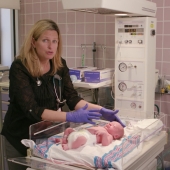A vaginal birth after a caesarean section is usually referred to as VBAC. Vaginal birth has physical as well as psychological benefits for both mum and baby; and women who are pregnant after a previous caesarean sometimes have a strong desire to experience a vaginal birth. However, some women are apprehensive about VBAC, especially if they previously had a difficult birth experience.
VBAC can be safer for a woman than a repeat caesarean, because a caesarean itself carries extra risks. For example, there is an increased risk of infection and a longer stay in hospital.
There are implications for future pregnancies too, including risks of placental problems, which increase with the number of caesareans a woman has, and a greater risk of needing an emergency hysterectomy (removal of the uterus).
As long as there isn’t a particular medical reason not to have a vaginal birth; VBAC can be a good option for you and your baby.
The scar on the uterus can cause a weakness in the uterine wall and the stretching that occurs during pregnancy or the strong contractions of labour can cause the scar to become thin or begin to separate.
This can happen among 0.5 to 2% of women. This is known as ‘scar dehiscence’ and it doesn’t usually cause any problem. However, if the uterine scar tears open, causing bleeding and other complications, it is called ‘uterine rupture’ and is a serious risk to both mum and baby.
Rupture happens in 0.35% of VBAC labours (approximately one in every 300), but good care and observation in labour means that if a rupture looks likely to occur, a woman will have a caesarean very quickly. An experienced midwife will monitor the baby’s heartbeat and mum’s pulse. This, along with watching for abnormalities, such as bleeding, or pain that lasts between contractions, allows an early warning of potentially serious problems.
If you and your doctor choose VBAC for this pregnancy, your labor will be mostly
normal. Your healthcare team will want to monitor you more closely, but during early labor you are able to move around as much as you want. When labor begins, VBAC restrictions kick in. You will need to remain in bed for continuous fetal heart monitoring. If you are taking too long to begin labor, labor may be induced, but most doctors try their best to avoid inducing VBAC labor. You may not be allowed any oral intake (food or liquid), since there is a chance of emergency C-section during a VBAC attempt.
Most women who choose VBAC can use pain medications after the cervix has opened to 3 – 4 cm. Typically, local anesthesia, epidurals, sedatives, and opioids (narcotics) can be used to relax you and relieve pain.
Source: http://www.nct.org.uk/birth/vaginal-birth-after-caesarean-vbac
- 5127 views













